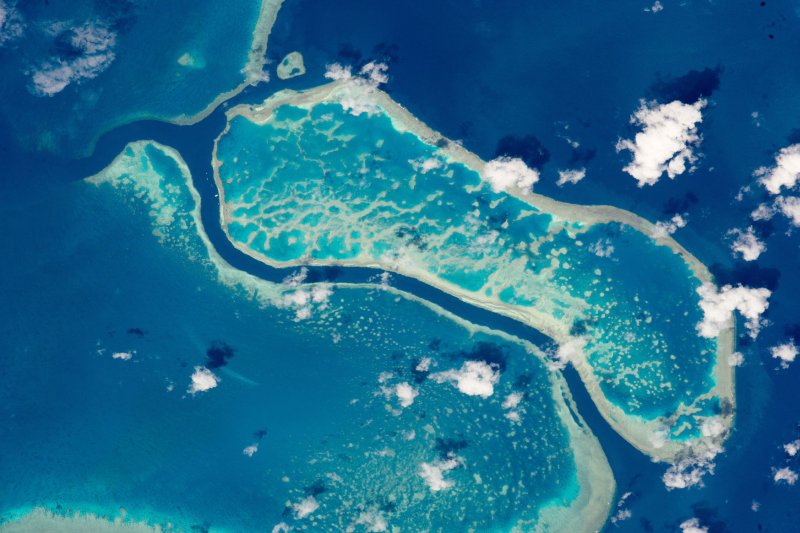Scientists have discovered new mechanisms driving the formation and growth of coral reef halos, but mysteries remain. Photo by NASA/UPI |
License Photo
April 26 (UPI) -- The ecological forces driving the development of sandy halos surrounding coral reefs are more complex than scientists previously realized.
For years, scientists had observed a mysterious phenomenon. Many coral reefs are surrounded by expansive halos of bare sand, some measuring hundreds of thousands of square feet. Typically, thick meadows of seagrass or algae grow beyond the edge of these halos.
Coral reef halos were first officially observed -- and documented in the scientific literature -- in the Caribbean, in St. John in 1965 and in St. Croix in 1972.
Until now, scientists' explanation for the phenomena was rather basic.
"They've been known for ages, and have been long assumed to be due to a simple chain of interactions: predators, fish-and invertebrate-eating fish, or herbivores, scare prey, plant-and algae-eating fish, who stay near shelter to avoid the predators and hence graze more heavily around the safety of coral reefs," Elizabeth Madin, assistant research professor at the Hawai'i Institute of Marine Biology, told UPI.
But many marine scientists wondered how some halos could grow so large if herbivores were scared to venture very far from the protection of the reef. Indeed, when Madin and her colleagues filmed the behavior of fish around reefs with halos, they found herbivore behavior alone failed to account for the barren sand.
"Plant-eating fishes never ventured as far from the reef as the halo boundary extended," Madin said. "This left us scratching our heads as to why, given that something was obviously casing the halo to extend out as far as it did."
When researchers monitored fish activity at night using GoPro cameras outfitted with special lights, they found an explanation: "bioturbating" fishes that root through the sand, turning up and eating invertebrate prey -- "sort of like pigs rooting through mud," Madin said.
All that rooting around dislodges the algae growing on the sand, expanding the halo.
Analysis of satellite imagery showed halos weren't likely to be larger in marine preserves, where the populations of predator fish are larger. However, scientists found reefs in preserves were more likely to host halos.
"Halo size seems to be dictated in large part by the size of the reef it surrounds, which is logical, yet the specific mechanics for why this is remain unclear," Madin said.
As the planet's oceans warm and become more acidic, and as unsustainable fishing practices proliferate, coral reefs are increasingly threatened. Madin and her colleagues hope their work -- published this week in the journal Proceedings of the Royal Society B -- will lead to more efficient ways to monitor reef health.
"Right now we're working hard to decode what the halos are telling us specifically about reef ecosystem health," she said. "In other words, we're trying to figure out the answers to the outstanding questions, such as what causes differences in the sizes of halos."
Once scientists can completely explain the mechanisms behind reef halo formation and size, analysis of halos via satellite imagery could be used as a conservation and management tool.
"That's my ultimate goal -- and the reason this somewhat mysterious phenomenon has had my collaborators and I captivated for the past few years," Madin said.















